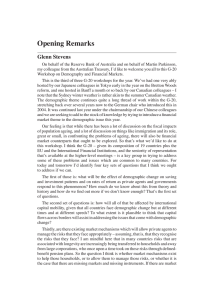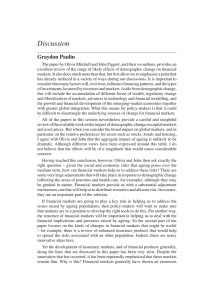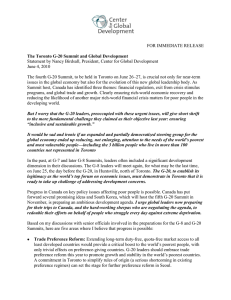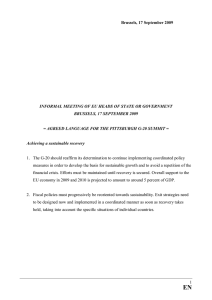Closing Remarks Glenn Stevens
advertisement
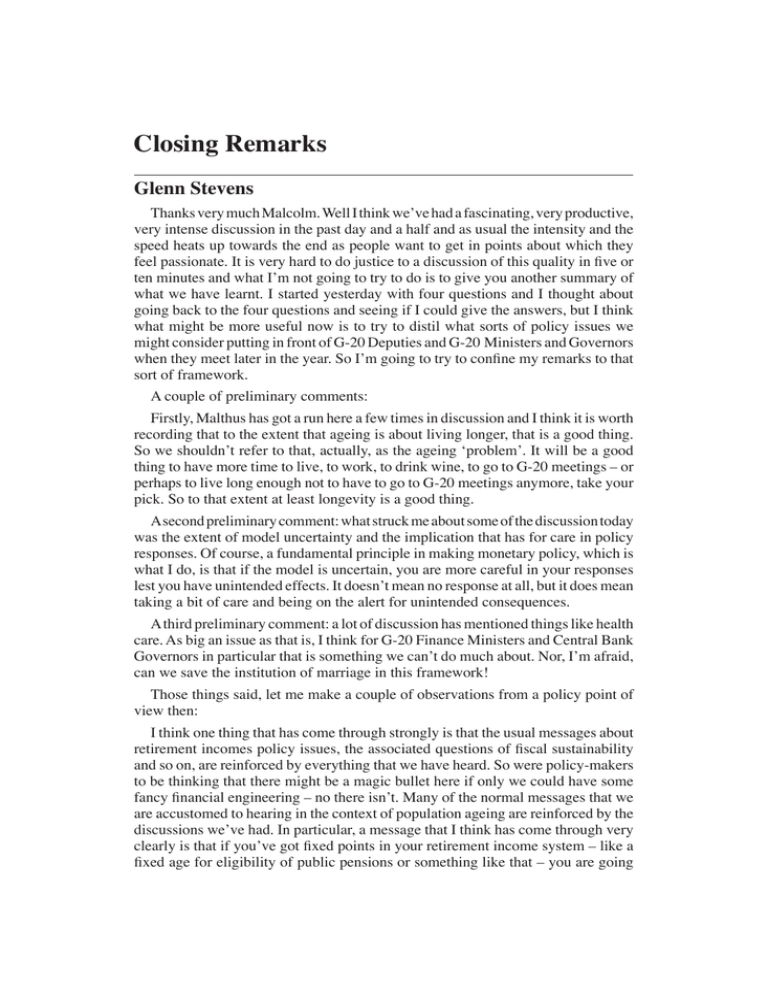
Closing Remarks 391 Closing Remarks Glenn Stevens Thanks very much Malcolm. Well I think we’ve had a fascinating, very productive, very intense discussion in the past day and a half and as usual the intensity and the speed heats up towards the end as people want to get in points about which they feel passionate. It is very hard to do justice to a discussion of this quality in five or ten minutes and what I’m not going to try to do is to give you another summary of what we have learnt. I started yesterday with four questions and I thought about going back to the four questions and seeing if I could give the answers, but I think what might be more useful now is to try to distil what sorts of policy issues we might consider putting in front of G-20 Deputies and G-20 Ministers and Governors when they meet later in the year. So I’m going to try to confine my remarks to that sort of framework. A couple of preliminary comments: Firstly, Malthus has got a run here a few times in discussion and I think it is worth recording that to the extent that ageing is about living longer, that is a good thing. So we shouldn’t refer to that, actually, as the ageing ‘problem’. It will be a good thing to have more time to live, to work, to drink wine, to go to G-20 meetings – or perhaps to live long enough not to have to go to G-20 meetings anymore, take your pick. So to that extent at least longevity is a good thing. A second preliminary comment: what struck me about some of the discussion today was the extent of model uncertainty and the implication that has for care in policy responses. Of course, a fundamental principle in making monetary policy, which is what I do, is that if the model is uncertain, you are more careful in your responses lest you have unintended effects. It doesn’t mean no response at all, but it does mean taking a bit of care and being on the alert for unintended consequences. A third preliminary comment: a lot of discussion has mentioned things like health care. As big an issue as that is, I think for G-20 Finance Ministers and Central Bank Governors in particular that is something we can’t do much about. Nor, I’m afraid, can we save the institution of marriage in this framework! Those things said, let me make a couple of observations from a policy point of view then: I think one thing that has come through strongly is that the usual messages about retirement incomes policy issues, the associated questions of fiscal sustainability and so on, are reinforced by everything that we have heard. So were policy-makers to be thinking that there might be a magic bullet here if only we could have some fancy financial engineering – no there isn’t. Many of the normal messages that we are accustomed to hearing in the context of population ageing are reinforced by the discussions we’ve had. In particular, a message that I think has come through very clearly is that if you’ve got fixed points in your retirement income system – like a fixed age for eligibility of public pensions or something like that – you are going 392 Closing Remarks to, sooner or later, have a problem and those fixed points actually would need to be moveable points in the future. So many of the normal messages about these things have come through again. A second point: I thought the distinction between longevity effects and fertility effects was particularly important because they have different implications. I never got the chance, but I wanted to ask which of these changes people thought would present the bigger challenge. On the one hand, longevity could, in principle, keep increasing indefinitely so it would require continual adjustment. On the other hand, fertility is ultimately about the survival of the human species, so presumably that becomes pretty important if fertility continues to decline! A theme we have heard repeatedly is the extent to which risks, particularly these longevity risks, have been transferred to households and away from institutions like large corporations or governments, which formerly bore them. There is actually a very big policy issue here, about the extent to which we want to leave households with all these risks, and the extent to which governments and society generally should bear some residual risk. That theme has come through on a number of occasions in our discussion and that’s a question to which we might suggest our Ministers and Governors give some thought. I’m not sure where they’d come down, but to the extent that households continue to face these risks there are policy responsibilities, firstly in terms of educating them as to the risks they have. And then the second issue is: are there market mechanisms in place and operating well to allow households to manage those risks, assuming that they can be educated to understand that they have them? I thought it was interesting that there probably was not all that much support in our discussion for the idea that asset markets will melt down. There do seem to be plausible, measurable effects of demographic variables on asset prices and returns but they are not large and, as I said yesterday, I think that leaves open the question of what’s causing all the other variation in asset-market prices and returns. That is important because of the risks remaining with households should they happen to retire at the wrong time. I take the point that was made today that you don’t have to annuitise all your wealth in the one year. That’s right, but nonetheless people who retired in about 1990 or 1995 did handsomely compared with those who retired in 1970, and I think that it just wasn’t possible for people to manage their way out of that problem. I think a theme which will be important to stress to Ministers and Governors is the need to keep markets open and well-functioning in general. I think where we came to on international capital flows is that they will help, but are unlikely to be big enough to be a magic bullet. So if you are thinking that ageing will be handled by immigration, by financial engineering, by just a bit more saving or by international capital flows, I think the answer is that none of these things in themselves are enough, though we do need all of these things working in our favour to handle this issue. Or if you did think that international capital flows were going to be a big part of the solution, what I took from Larry Kotlikoff’s paper is that the size of capital flows that you would see are nothing like we have ever seen before. The baseline scenario in that paper had current account deficits for the United States of 16 per cent of GDP Closing Remarks 393 and some of the other scenarios 20 or 30 per cent or even more. So if international capital flows are a big part of the answer, they are much bigger flows than we have ever been accustomed to thinking about and we would need to completely rethink the way we analyse those flows. Keeping markets open and well-functioning also involves making sure they efficiently allocate and manage the savings that people accumulate. Here there are a number of issues related to regulatory oversight, supervisory oversight and the need to be alert to unintended consequences from these. I regard what has been happening in the United Kingdom indexed-bond market as basically an unintended consequence of a well-meaning reform which will, if it persists, raise the cost of providing those pension benefits over the long run. That is, presumably, not what the regulators intended. Transparency of costs and fees is an issue which is growing and which will grow further. When nominal yields on retirement assets were in the teens, no one worried about giving away 100 or 200 basis points a year to have these funds managed; they never asked any questions. Now that the returns are 5, 6 or 7 per cent, this is a much bigger question, and I think there is potentially a role for policy-makers in enforcing transparency there. On the issues of missing markets, missing instruments and what we do there, there does seem to be a set of concerns around whether there is enough capacity to annuitise. Here I am a little uncertain whether the real problem is the capacity to annuitise or the incentive to do so, or some mix of those depending on what the public-sector schemes are offering. But to the extent there is an issue of capacity, I suppose policy-makers have three types of responses they could think of. One is the provision of information, and today we talked about the need for better information on mortality or on house prices, or whatever it may be, depending on what instrument we are talking about. So there may be a case for public policy to try to force the pace, perhaps by collecting the information itself. I can say that in this country the issue of house price information is one that the central bank has put a lot of resources into – not because of ageing issues but because we wanted to know what was going on in that market and the statistics were so poor. But in general there is perhaps a role for public policy there. There’s probably also a role in ensuring that there are no unintended impediments, be they of a regulatory or a tax nature for the development of appropriate instruments. That is something policy should always be doing anyway but it is no less urgent in light of these ageing issues. Policy would be saying:‘here, we’re setting some preconditions for markets, now markets off you go and sort all this out’. The bigger, more forceful response, and probably more controversial one, would be for governments themselves to get into the issuing of some of these instruments, if we thought the private markets were not going to do so. As Todd Groome said, there is ample precedent for governments being involved in tail insurance in other areas, so this is not a crazy idea, but I think governments who were inclined to issue longevity bonds, or whatever it may be, are then actually themselves taking on a set of risks and they’ve got to think about how to manage those risks. It may well 394 Closing Remarks be that we conclude in the end that these are risks that only can be managed by the government, but we should go into that with our eyes open. I could say more but I think that is enough. There’s been a rich vein of issues mined here in the last day and a half. Again thanks to all the people who’ve contributed to that. What we’ll do now is to try and write up a summary of these issues and the discussion that will be available to participants and to the G-20 process and from there we will seek to fashion a useful discussion for our Ministers and Governors later in the year. Let me now hand over to Martin who has one or two observations and then a farewell word for you. Thank you. Martin Parkinson Thanks Glenn. If what I say sounds eerily similar to some of the things Glenn has mentioned just now, put it down to the close working relationship of the RBA and the Treasury. A good conference is one where you leave with one new idea or fact, so I think this must have been a great conference because not only am I leaving with a new word, pro-natalist, which I heard for the first time yesterday, but with a mix of ideas that we will want to grapple with in the period ahead. I think the presentations and discussions have been excellent. I would like to just make a few comments on the issue of risk and touch on some policy issues. The thrust of much of the reform that has been undertaken in Australia and other countries in recent years has been to transfer risks from governments or corporations to households. You see that in labour market reform, you see it in tariff reform and in changes in the funding and provision of health care, the move from defined benefit to defined contribution pension schemes, and so on. When I think about the transfer of risk in relation to ageing though, I am not quite sure whether we know enough to decide the optimal path to follow. It might be that the incompleteness of markets that we talked a bit about yesterday is simply a transitory phase during which both the demand and supply side are adjusting; people have to become better educated about their own situation and markets have to develop, and that doesn’t happen instantaneously. But there may also be key issues that policy-makers need to address on both the supply and demand sides. If households really are myopic, is there a role for policy-makers to create a mandatory saving component? If markets are leaving profitable opportunities on the table by being unable or unwilling to create new products, is there a role for government to either provide those instruments – those risk sharing and management tools – or to somehow facilitate their development by the private sector? Despite the past day and a half of discussions, I don’t have a sense that we have reached a conclusion around these issues in terms of what should be done. In contrast, Closing Remarks 395 I take away a very unambiguous message that we need to engage in a dialogue with our citizens to ensure that they are under no illusions about the magnitude and the types of risks that they confront. We need to educate them so they can take better decisions, and in Australia we have been very successful at one level in getting people to understand the demographic challenge in aggregate. But as I said yesterday, we have been unsuccessful to date in getting them to think through how best to provide for their retirement, and this is notwithstanding the attention and publicity given to the Intergenerational Report (which we produce every five years). Also, I think that we haven’t explained enough to them about why we are forcing them into mandatory saving with our superannuation guarantee charge. The inability of both public and private sectors to convince people of the importance of appropriate levels of funding for their own retirement is demonstrated by the fact that we have found the need to launch a major financial literacy program, again notwithstanding all the media attention in recent years on appropriate saving behaviour, retirement planning and money management. This program is intended to get people from a very young age to understand the need to provide for themselves, and to understand better exactly how much they might need to save, and when. Glenn talked about a range of things that the policy-makers in the G-20 could usefully focus on. It strikes me as obvious that we need to improve the data and to begin to ask ourselves how we might facilitate some of the practical solutions that people put on the table, such as the creation of longevity indices. Bringing together the policy-makers within the G-20 can help, especially if we give people the task of coming up with small but concrete steps to follow. In this way, I think that we can actually address some of these issues. It should be clear though that further education of the public will inevitably promote further debate about the extent and nature of risks society wants individuals to manage. As economists, we may not like the outcome of those debates. But it is a debate that we should be encouraging society to have. Glenn also touched on the issue of market openness being important if we want society to deal with the implications of ageing in a macroeconomic sense. One striking observation is that when thinking about the solutions to the ageing challenge we keep coming back to the sorts of domestic reforms that we have highlighted previously in the G-20 Accord for Sustained Growth: the importance of having flexible markets, clear signals, not having inhibitions over the way in which resources and assets can move, and so on.1 It is important that we continue to reiterate these things because, like Glenn, I take away from our discussions that most of the solutions are going to have to be undertaken at a national level. We are looking at supra-national solutions and, yes, international capital flows and migration and the like will have to be part of the portfolio of responses, but ultimately, much of the response will take place at home. 1. See <http://www.g20.org/Public/Publications/Pdf/2004_g20_accord_for_sustained_growth.pdf> for details.
